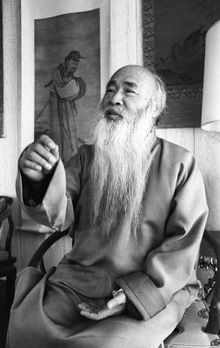- Chang Dai-chien
-
Chang Dai-chien
張大千
Birth name Zhāng Zhèngquán (張正權) Born May 10, 1899
Neijiang, Sichuan, ChinaDied April 2, 1983 (aged 83)
Taipei, TaiwanNationality Chinese Field painting Movement guohua, impressionism, expressionism Chang Dai-chien (simplified Chinese: 张大千; traditional Chinese: 張大千; pinyin: Zhāng Dàqiān; Wade–Giles: Chang Ta-chien) (May 10, 1899 – April 2, 1983) was one of the best-known and most prodigious Chinese artists of the twentieth century. Originally known as a guohua (traditionalist) painter, by the 1960s he was also renowned as a modern impressionist and expressionist painter. Chang is regarded as one of the most gifted master forgers of the twentieth century.
Contents
Background
Born in a family of artists in Neijiang, Sichuan, China, he studied textile dyeing techniques in Kyoto, Japan and returned to establish a successful career selling his paintings in Shanghai.
The Chinese Muslim General and Governor of Qinghai, Ma Bufang sent Chang to Sku'bum to seek helpers for analyzing and copying Dunhuang Buddhist art.[1]
A staunch supporter of the Kuomintang, he left China in 1948 and moved to Mogi das Cruzes, Brazil, and then to Carmel, California, before finally settling in Taipei, Taiwan.[2]
A meeting between Chang and Picasso in Antibes in 1953 was viewed as a summit between the preeminent masters of Eastern and Western art. The two men exchanged paintings at this meeting.[3]
Forgeries
Chang's forgeries are difficult to detect for many reasons. First, his ability to mimic the great Chinese masters:
So prodigious was his virtuosity within the medium of Chinese ink and colour that it seemed he could paint anything. His output spanned a huge range, from archaising works based on the early masters of Chinese painting to the innovations of his late works which connect with the language of Western abstract art.[4]Second, he paid scrupulous attention to the materials he used. "He studied paper, ink, brushes, pigments, seals, seal paste, and scroll mountings in exacting detail. When he wrote an inscription on a painting, he sometimes included a postscript describing the type of paper, the age and the origin of the ink, or the provenance of the pigments he had used." Third, he often forged paintings based on descriptions in catalogues of lost paintings; his forgeries came with ready-made provenance.[5]
Chang's forgeries have been purchased as original paintings by several major art museums in the United States, including the Museum of Fine Arts, Boston:
Of particular interest is a master forgery acquired by the Museum in 1957 as an authentic work of the tenth century. The painting, which was allegedly a landscape by the Five Dynasties period master Guan Tong, is one of Zhang’s most ambitious forgeries and serves to illustrate both his skill and his audacity.[6]James Cahill, professor emeritus of Chinese art at the University of California, Berkeley, has claimed that the painting "The Riverbank," a masterpiece from the Southern Tang Dynasty, held by the New York Metropolitan Museum of Art, is likely another Chang Dai-chien forgery.[7]
Museum curators are cautioned to examine Chinese paintings of questionable origins, especially those from the bird and flower genre with the query, "Could this be by Chang Dai-chien?"[6] Joseph Chang, curator of Chinese art at the Sackler Museum, suggest that many notable collection of Chinese art contains a forgery by the master painter.[7]
See also
References
- ^ Toni Huber (2002). Toni Huber. ed. Amdo Tibetans in transition: society and culture in the post-Mao era : PIATS 2000 : Tibetan studies : proceedings of the Ninth Seminar of the International Association for Tibetan Studies, Leiden 2000. BRILL. p. 205. ISBN 9004125965. http://books.google.com/books?id=bLcWyecDpIcC&pg=PA205&dq=ma+bufang+buddhist+zhang#v=onepage&q=ma%20bufang%20buddhist%20zhang&f=false. Retrieved 2011-05-29.
- ^ Sullivan, Michael (2006). Modern Chinese artists: a biographical dictionary. Berkeley, California: University of California Press. p. 215. ISBN 0520244494. OCLC 65644580.
- ^ Sullivan, Michael (1973). The meeting of Eastern and Western art. Greenwich, Connecticutt: New York Graphic Society. p. 198. ISBN 0821205439. OCLC 967349.
- ^ Jiazi, Chen; Kwok, Ken (2001), Chang Dai-Chien: The Enigmatic Genius, Singapore: Asian Civilisations Museum, p. 9, ISBN 9814068217, OCLC 48501375
- ^ Fu, Shen CY (1991). "3. Painting theory". Challenging the Past: The Paintings of Chang Dai-Chien. Seattle, Washington: Arthur M Sackler Gallery, Smithsonian Institution; University of Washington Press. pp. 37–8. ISBN 0-295-97125-8. OCLC 23765860.
- ^ a b "Zhang Daqian — Master Painter / Master Forger". Art Knowledge News. Art Appreciation Foundation. 2006. http://www.artknowledgenews.com/Zhang_Daqian_Master_Painter-Master_Forger.html. Retrieved 24 March 2010.
- ^ a b Pomfret, John (January 17, 1999). "The Master Forger". The Washington Post Magazine: W14.
External links
- Zhang Daqian and his Painting Gallery at China Online Museum
- Chang Dai-chien Residence Memorial Hall at National Palace Museum
- Chang Dai-chien in California at San Francisco State University
- Chang Dai-chien biography (asianart.com)
- Chang Dai-chien at the Cultural Affairs Bureau of Macao
- Video tour of the Chang Dai-chien Residence Memorial Hall
Categories:- 1899 births
- 1983 deaths
- Art forgers
- People from Sichuan
- Chinese painters
- Nanjing University faculty
- National Central University faculty
- People from Neijiang
Wikimedia Foundation. 2010.
